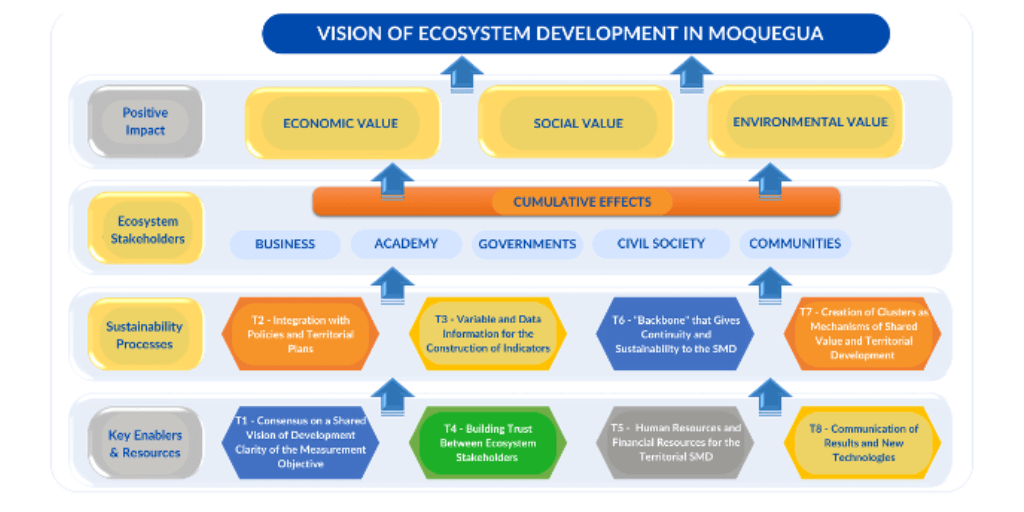How can we measure the progress of territorial development?
An application of Moquegua, Perú
[Editor’s Note: How can we assess development at the subnational level over time? How do we know that a country’s region is meeting its goals? In Peru, the Planes de Desarrollo Regional Concertado (PDRC) are the planning instruments guiding the management of a regional government in the medium and long term. They are developed in broad, plural participatory processes to include a wide range of perspectives from different elements of the local society. However, until recently, those processes did not have a monitoring plan attached to them that would allow proper evaluation of implementation progress. And those that now do, are typically organized around administrative units, rather than following the logic of territorial development PDRCs are supposed to have. Results for Development, as part of the Leveraging Transparency to Reduce Corruption (LTRC) initiative with the Brookings Institution, has been supporting the Moquegua region in Peru with a strategy focused in strengthening local stakeholder agency and fostering co-creation processes for the solution of concrete challenges. This post is part of a collaboration between R4D and GĚRENS in Perú. Access the Spanish translation here.]
Territorial development is a process of social construction that puts at the center the analysis of where economic and social activities and relationships happen. It considers resources, actors and economic and sociopolitical dynamics closely in each place and identifies challenges and opportunities in that territory, with consequences for the identification and prioritization of policies.
The logic behind territorial development calls for a performance measurement system that is adapted and built around territorial development plans, integrating the strategies of different actors, including the state, but also private companies, civil society, and international cooperation. The integration of the strategies of those stakeholders present in the ecosystem has the potential for incremental value creation.
In Moquegua, a region in Southern Peru with a heavy presence of mining activity, which generates substantial royalties and mining revenue for the region, GĚRENS and R4D recently explored how a territorial development performance measurement system would look with the opportunities and risks associated with such a large influx of revenue included in it.
The diagnostic we conducted in Moquegua has shed light on some strengths in the region. These include the existence of performance measurement initiatives with previous data, and the presence of local technical capacity to build and manage a measurement system of this kind. Furthermore, another strength resides in the interest and participation of local citizens and entities, who want to be active actors in the implementation of the PDRC process.
The diagnostic also revealed weaknesses, including the lack of coordination and communication between actors, and an unfledged system of accountability and financial management.
Thus, the study revealed important action areas for the construction of an appropriate performance measurement system. These include: a shared vision of development, integration between local politics and territorial development, an increase in trust between actors, and the need for sustainability and continuity of the implemented vision. In addition, measurement systems also need an element of long-term monitoring. In the figure below, you can see how a performance management system can contribute to shared value and increased development.
Performance management system and shared value tools
Source: Gallegos et al. (2022). El Balanced Scorecard a nivel ecosistema en territorios mineros. Escuela de Postgrado GĚRENS, Lima. Perú
In order to move forward with the performance measurement system as part of a territorial development approach, we have created a roadmap. The roadmap is split into three phases: preparatory, design, and implementation phases. The roadmap identifies clear steps for each phase as well as the importance of establishing collaboration between the relevant actors. You can access the Spanish version of the roadmap here.
Moquegua has the tools and capabilities needed to use a territorial development approach successfully. Not only will the approach improve the use of mining revenue from the Canon Minero, but it will also increase coordination among different actors to achieve the local development vision for the region. If this model is successful, it will become an example for other Peruvian regions.
Moquegua is a region that has potential to establish a territorial development performance measurement system that helps improve the use of mining resources and demonstrates coordination between actors in the region to achieve cumulative effects of value creation for the benefit of territorial development, with the ultimate goal of achieving the regional development vision. The LTRC initiative and the MinSus/GIZ program have supported recent efforts to put together a broad catalogue of indicators that can, in an eventual monitoring system, specifically help tackle actions recommended under the PDRC and the subnational mining vision processes that Moquegua stakeholders have engaged in over the last couple of years. The foundations are there to set up a system that would allow for more effectiveness and accountability in the use of revenue, particularly mining revenue, towards a more robust process of territorial development.
Armando Gallegos, PhD, is the director and one of the founders of GĚRENS, an academic institution in Lima that specializes in providing innovative education services for professional development, focusing on key sectors. He is a researcher and professor with broad experience in strategic management and organizational design.
Supriya Sadagopan is a program officer with R4D’s Governance Team and has been working on the LTRC initiative for the past three years.














